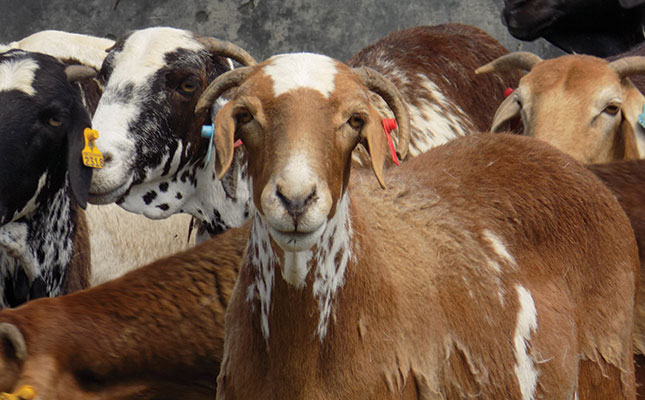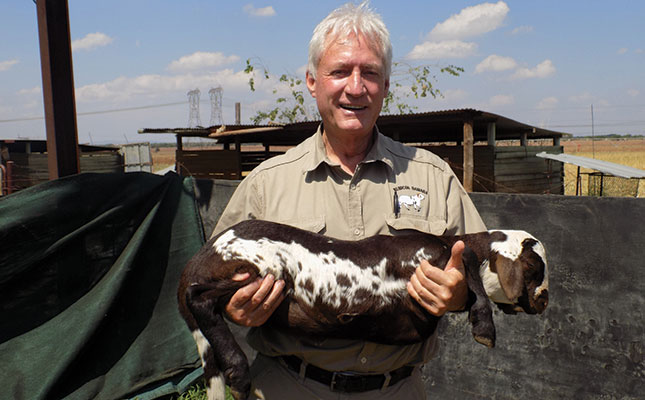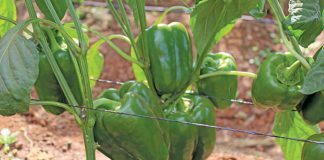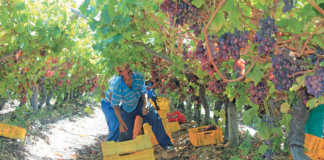
Photo: Annelie Coleman
The sorting of semen according to gender has brought great success for Stan Burger, owner of the Rubicon Damara Stud near Koster in North West. He is the first Damara breeder in the world to make use of the latest semen-sexing technology.
Burger bought his first Damaras in 2004 to combat the wattle that covered much of his farm.
“These animals eat virtually anything and have, to a great extent, annihilated this invader,” he says.
Burger, who is president of the Damara Breeders’ Association of South Africa, adds that stock farmers are increasingly recognising the Damara as a worthwhile contender in the sheep-breeding industry.

“The breed has retained its robust genetics [over two millennia] and the onus now rests on us as breeders to preserve its pure genetic base. It’s an economical and profitable sheep breed, ideally suited to the challenges of modern-day sheep farming with its increasing input and production costs.”
Sexed semen
According to Burger, using sexed-semen technology has resulted in rapid genetic progress, higher lambing percentages and shorter lambing periods in his 800-strong Rubicon stud.
“I needed to expand my stud as a matter of urgency because of the sharp increase in demand for top-quality Damara breeding material. But using the traditional approach would have taken far too long.”
Seventy-eight embryos, flushed from 10 selected Rubicon donor ewes, were transferred to 48 surrogate ewes on 25 May 2021. This was followed by the transfer of a further 56 embryos to 33 ewes on 30 June 2021. (The latter ewes were yet to lamb at time of writing.) The egg cells were fertilised with female (X chromosome-bearing) sperm from the ram Rubicon Max.
“From the first 48 ewes, we realised a lamb harvest of 44 ewe lambs and only one ram lamb,” says Burger. “This is a success rate of more than 98% for sexed semen and a 60% transplanted embryo survival rate.
“Although the technology is relatively expensive, the benefits by far surpass the cost. It will allow me to increase my stud to the envisaged 1 800 animals within the next two years.”
Flushing and transfer costs amounted to R2 500/ ewe, and the sexed semen cost
R360/ straw. Between five and six straws are used per embryo-donor ewe. Burger
has retained 400 Rubicon Max semen straws and plans to repeat the sexed-semen process in February and March 2022 in his quest to accelerate the size of his flock with the very best Damara genetics.
“I prefer to use stud ewes as surrogate mothers. The Damara has a strong flocking instinct and the lambs need to grow up in the flock to learn to adapt and behave according to flock dynamics. The breed’s strong flocking instinct gives the lambs optimal protection, particularly from predation by jackal, and also makes mustering easy,” he adds.
According to Dr Fanie Steyn, a veterinarian and the managing director of embryo flushing and laparoscopic programmes at Ramsem, the use of traditional semen for artificial insemination results in a 50% chance of having either male or female offspring. With sexed semen, more than 90% of the gestating female animals will deliver a lamb of the breeder’s choice of sex.
High-end technology
“By using the best breeding material, combined with double the number of replacement ewes available for selection, a farmer can achieve a drastic leap in genetic progress,” says Steyn.
“The use of sexed semen is also extremely popular with in-vivo [programmes].”
Ramsem has secured a contract with US company Sexing Technologies for the use of its patented SexedULTRA Genesis sorting machine.
“The technique involves staining the sperm [cells] with a fluorescent agent before sorting,” explains Steyn. “The stained sample is then transferred into the flow-spectrophotometer in droplets, where each droplet carries a single sperm cell [with either an X or Y chromosome].
“Due to their 4% more DNA content, the female sperm cells fluoresce more than the
males when exposed to light. This enables the flow-spectrophotometer to distinguish between male and female sperm cells by means of sophisticated software and a laser, and a positive or negative charge is applied to the stained droplet.
“Male (negatively charged) and female (positively charged) sperm cells are then separated by deflector plates as the stained droplets move through the flow-spectrophotometer, while defective or dead sperm cells are discarded.”
Steyn says these straws contain a minimum of 90% sperm cells of the chosen sex. Samples are taken of each ram before sorting to ensure that the morphology, motility and concentration of the semen sample meet all the standards of Sexing Technologies for successful sorting on the Genesis machine.
“The initial collection of a semen sample, called a clean-out (CO), takes place seven to 14 days before the desired sorting date. “If the quality of the semen is not up to standard, another ejaculate will be examined or another arrangement made.”
The COs can be carried out on-farm by Ramsem-approved veterinarians two weeks prior to moving a ram into the station. Sexed semen straws contain a significantly lower concentration of sperm cells (two to four million each) than do traditional semen straws (15 to 20 million each), as most of the defective or dead sperm are removed during the sorting process. For this reason, the conception rates of sexed and conventional semen are similar.
“Most sexed semen is available in straws of two million sperm [cells],” explains Steyn.
“With the new four million (SexedULTRA 4M) straws, the concentration of semen is doubled, which can lead to a 7% increase [in] conception when using frozen semen.
“There’s also the option of fresh sex-sorted semen, either at two million or four million concentrations. Further advances in the fresh semen extender allow for a holding period of up to 72 hours after collection of fresh semen samples.”
Burger stresses that donor ewes should be in good condition and in a weight-gaining phase before entering the oestrus synchronisation programme. In this programme, hormones are used to induce fertility during a specific period. Burger maintains this weight-gain phase meticulously, providing the ewes with teff and a high protein and energy ration, until the embryos are transferred laparoscopically into the surrogate ewes.
After implantation, the surrogate ewes are kept in a stress-free environment and on the same ration for six weeks to ensure that the maximum number of embryos take.
The ewes are then returned to their normal pastures. In the case of Rubicon, the surrogate ewes are taken to green oat pastures one week before they lamb, and remain there until after lambing. The lambs are weighed and tagged during the first 24 hours of their lives and moved back to extensive pastures with the ewes after two weeks.
Email Stan Burger at [email protected], or Dr Fanie Steyn at [email protected].











